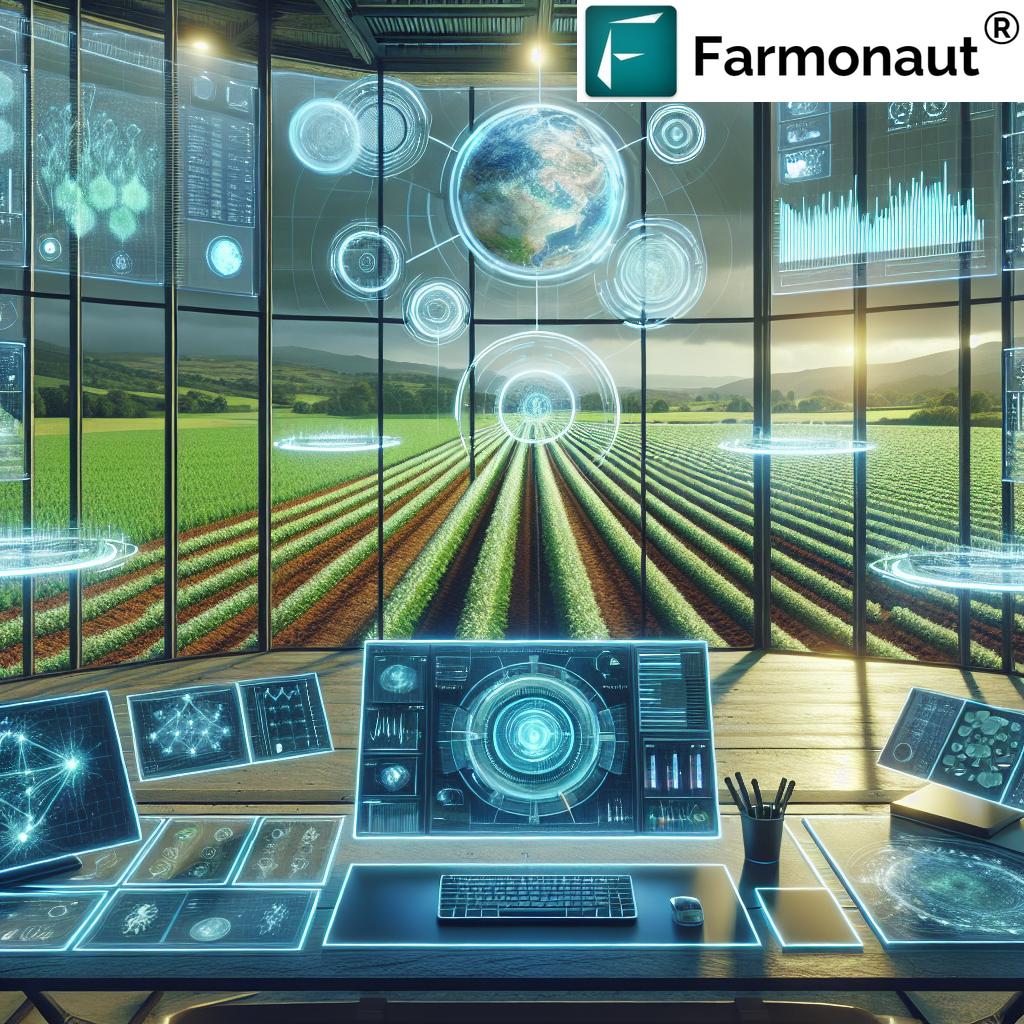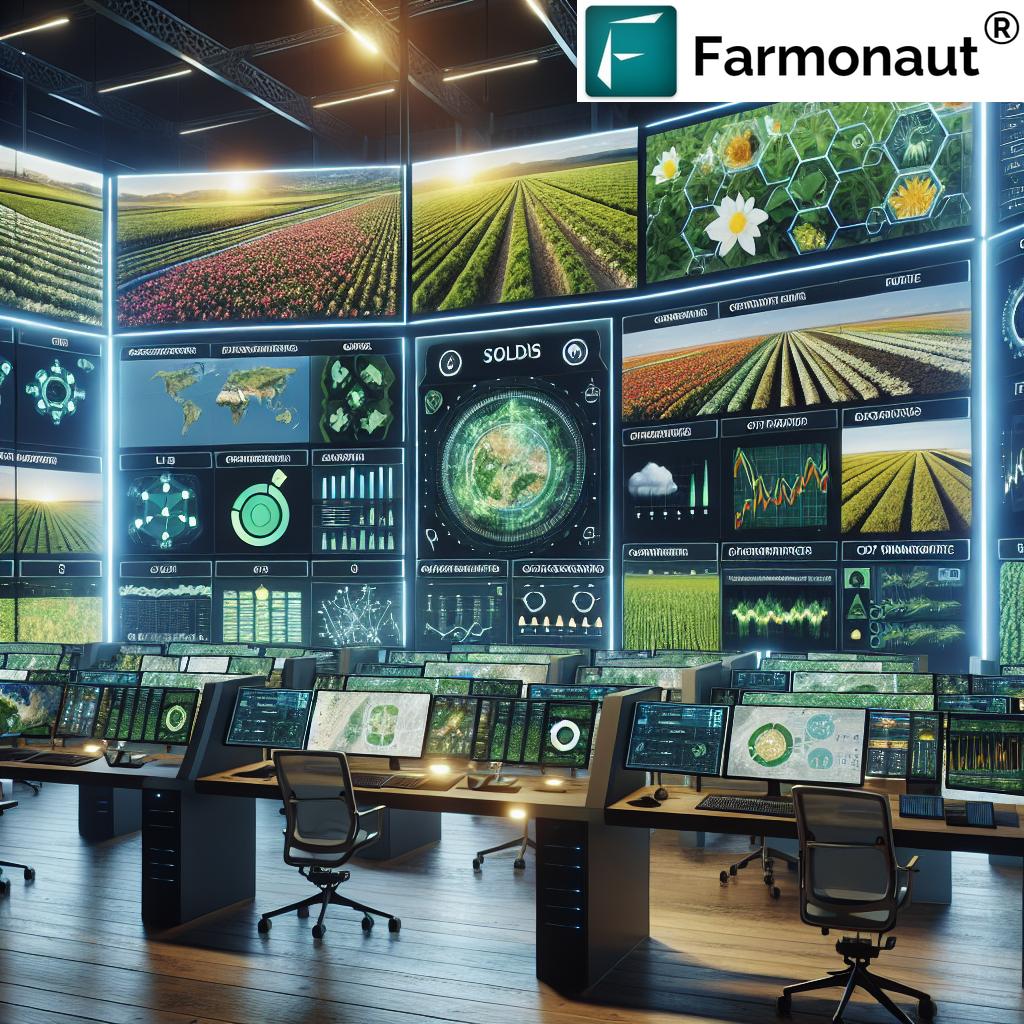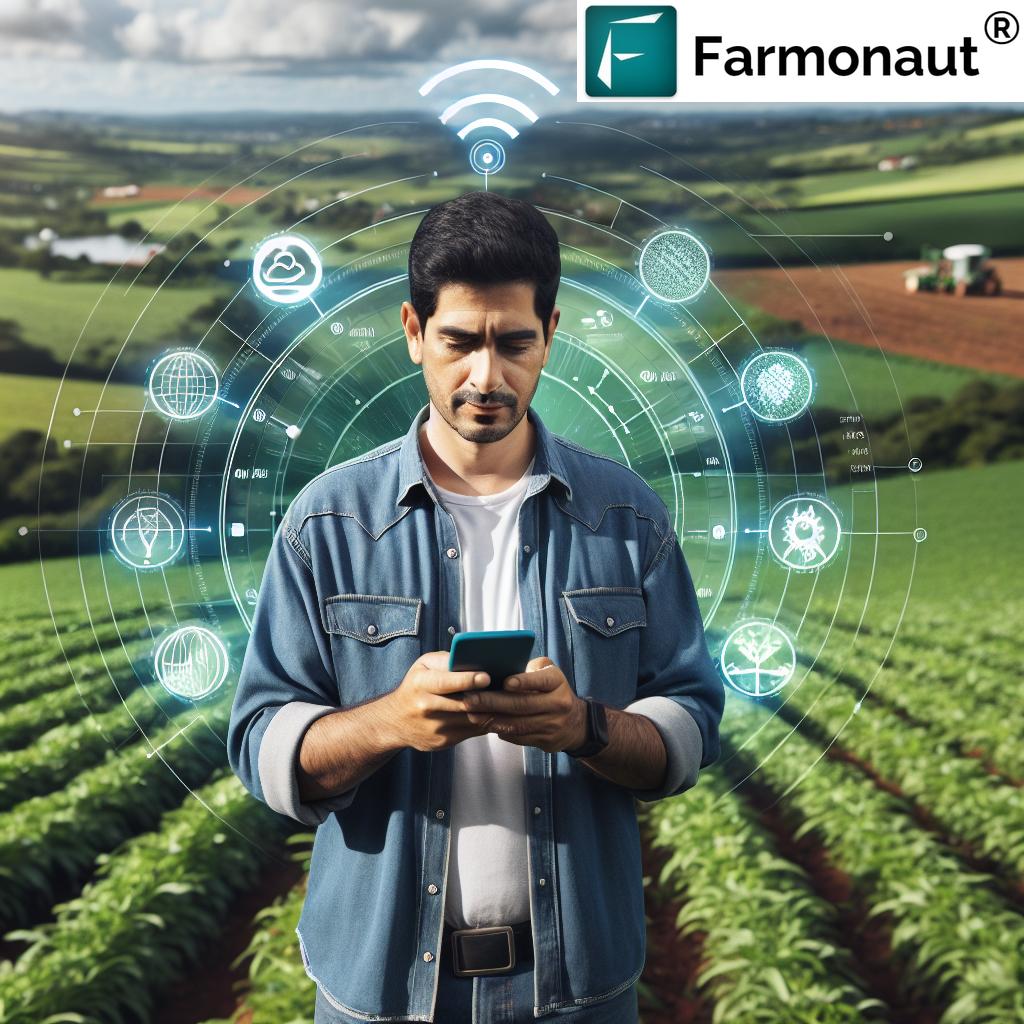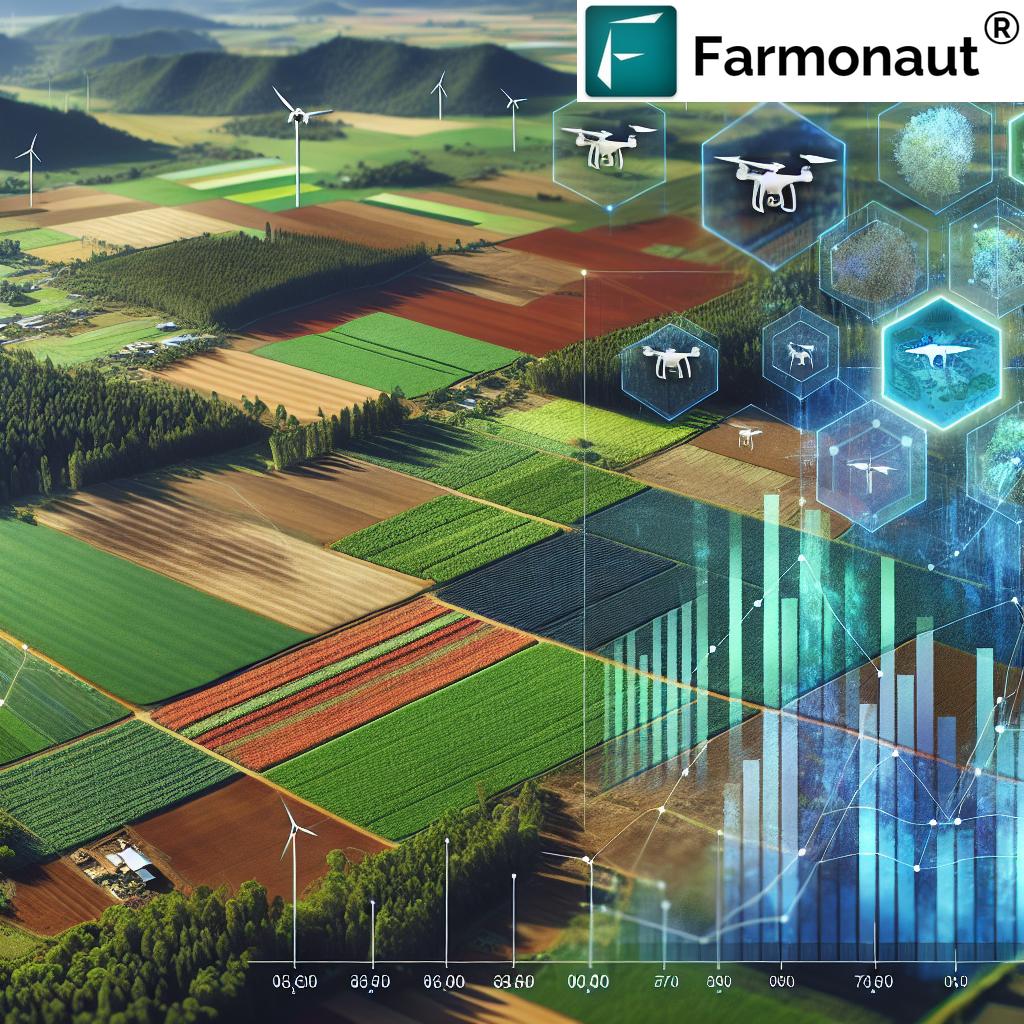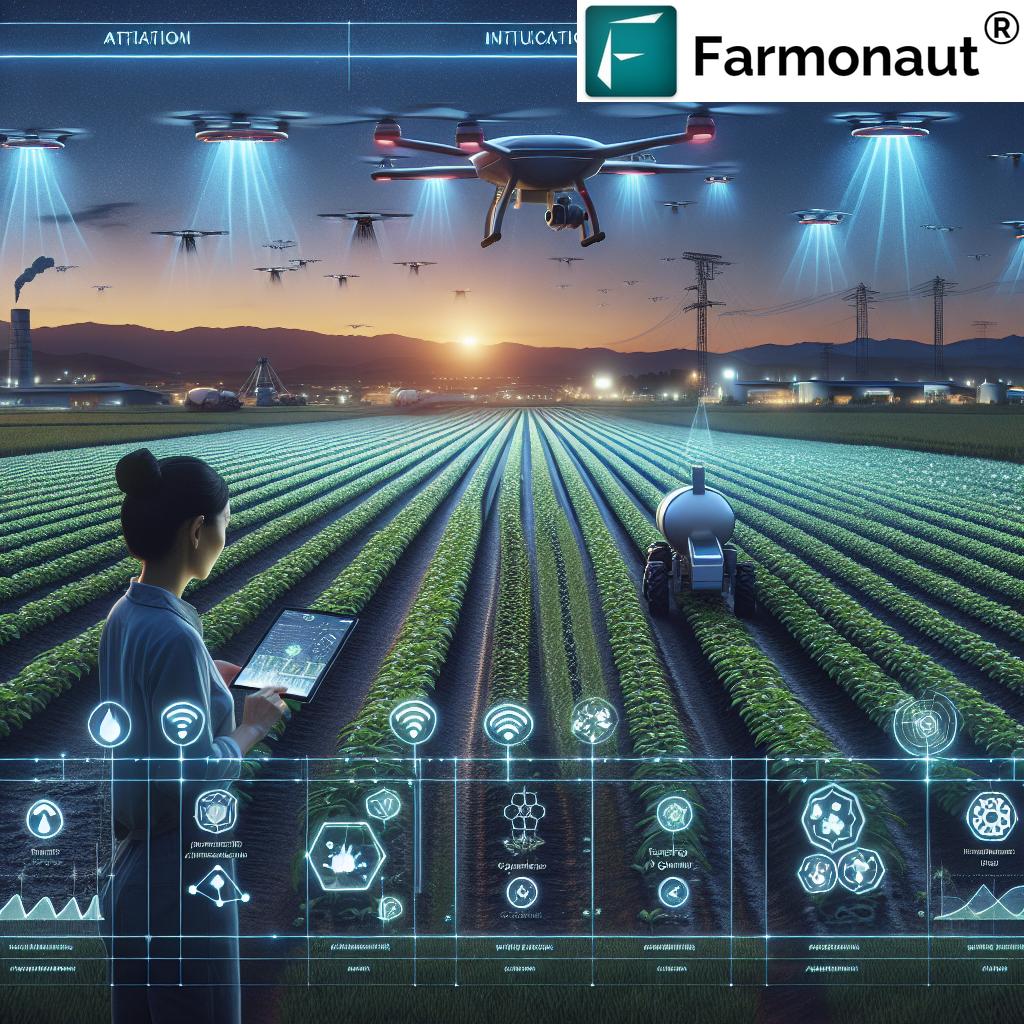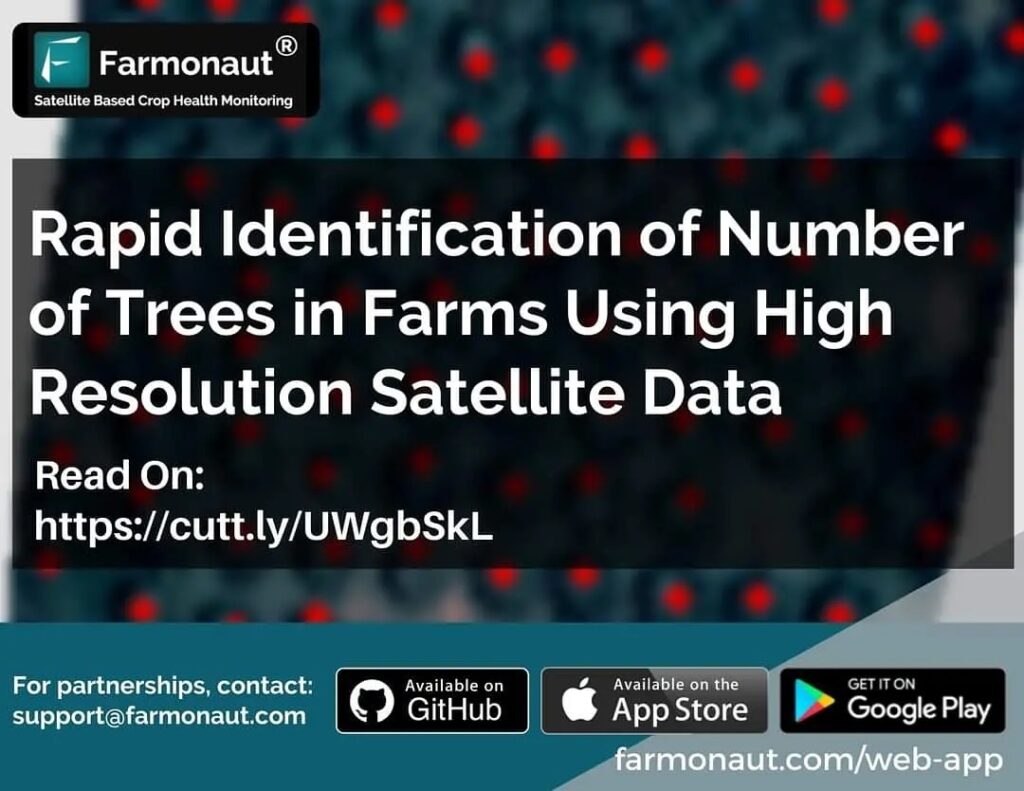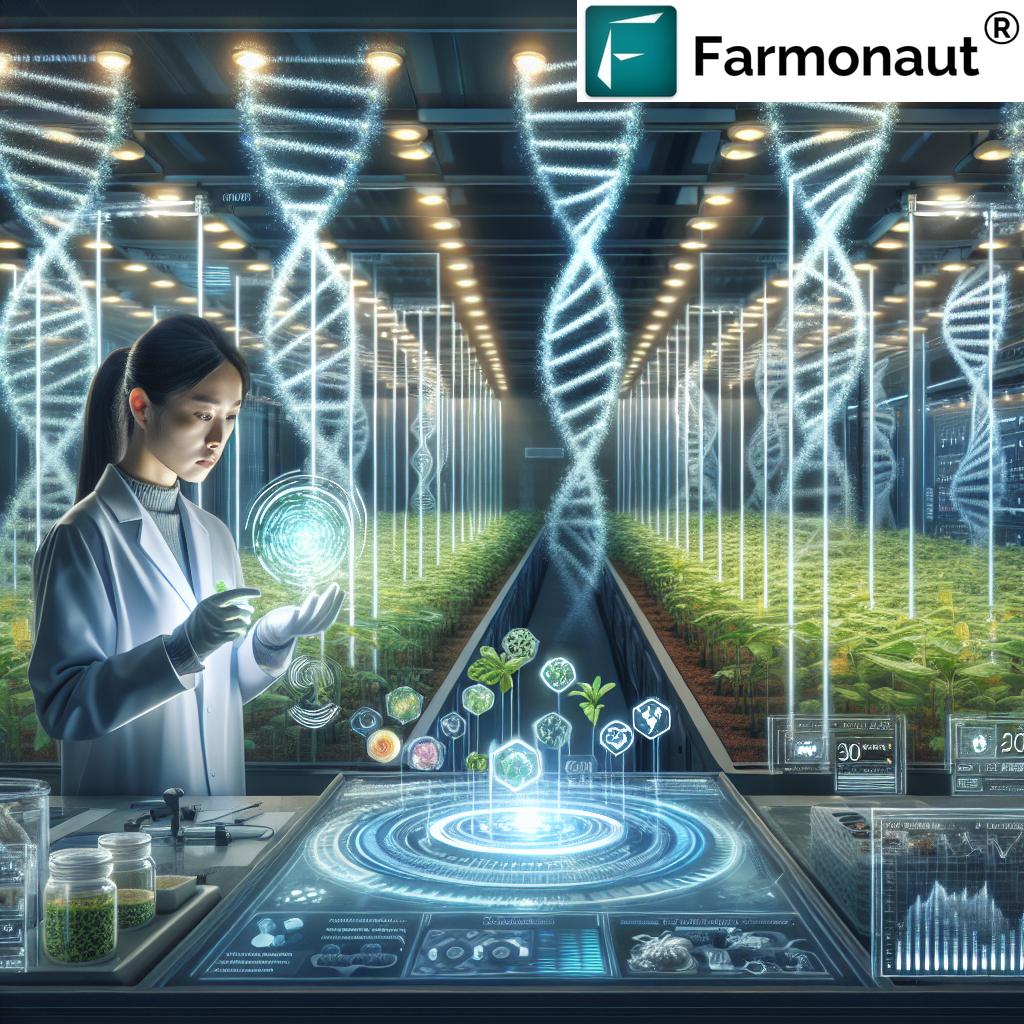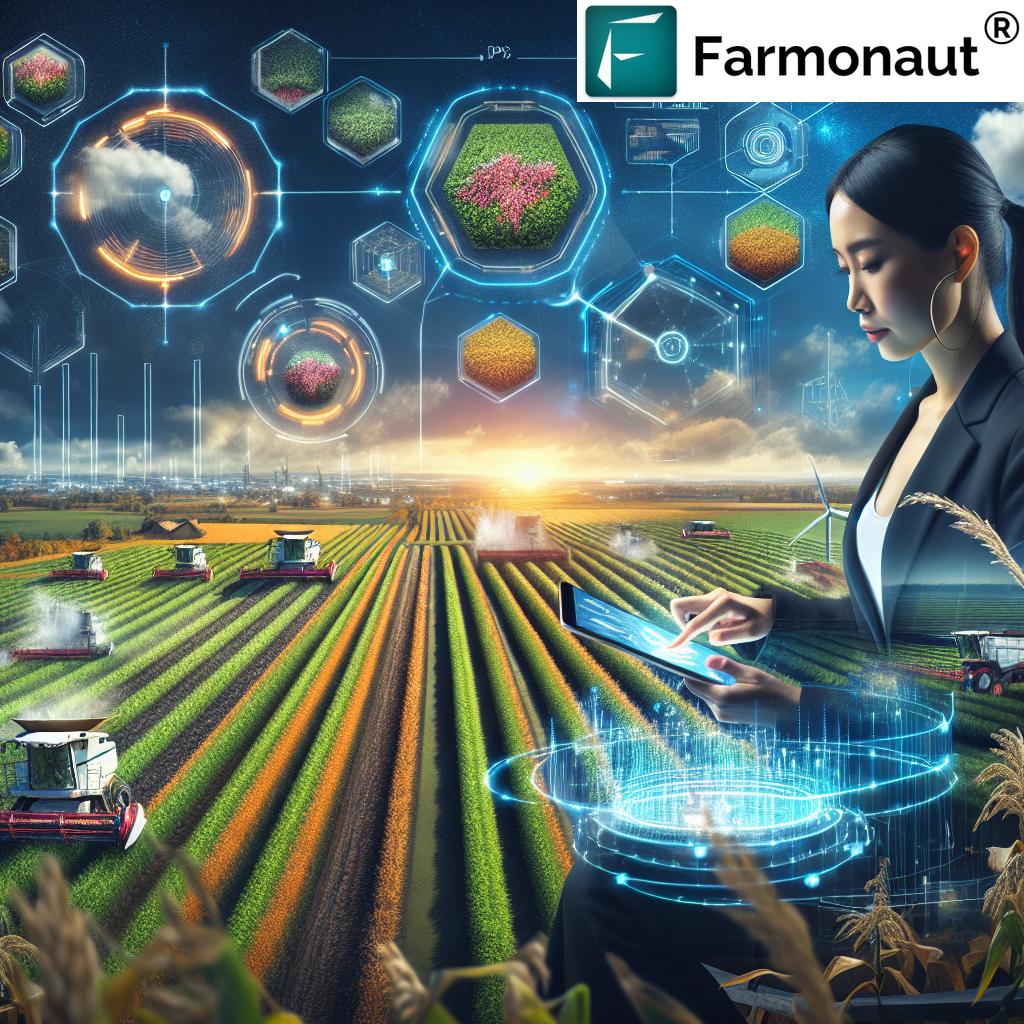Smart Agriculture Solution Market: 2024’s Surprising Growth
“The smart agriculture solution market is projected to surpass $22 billion globally by the end of 2024.”
Smart Agriculture Solution Market Overview 2024
Smart agriculture solutions have taken center stage in global agricultural transformation. In 2024, our industry is witnessing a surging demand for technology-driven farming to address food security, resource efficiency, and environmental resilience. Technologies like IoT devices in agriculture, AI in agriculture, and precision farming technologies are fundamentally changing how we monitor, manage, and scale sustainable farming.
As we explore this landscape, the smart agriculture solution market is projected to surpass USD 22 billion by the end of 2024 and is poised to reach a staggering USD 74.03 billion by 2034. This reflects a remarkable compound annual growth rate (CAGR) of 12.4% between 2024 and 2034 (precedenceresearch.com). These figures underscore not just growth, but a paradigm shift rooted in technology adoption, government initiatives, and the urgent need for climate resilient agriculture.
Our collective mission is clear: empower farmers with innovative tools and insights to maximize yields, reduce resource wastage, and enable globally sustainable food systems. Let’s journey through the drivers, technologies, and transformative trends shaping this fast-growing sector.
“AI-driven precision farming technologies are expected to increase crop yields by up to 30% in 2024.”
So, what is powering the expansion of smart agriculture solutions in 2024? Let’s unravel the key drivers and market forces at play.
Key Drivers of Growth in Smart Agriculture Solutions
1. Technological Advancements and Integration
- IoT devices in agriculture have enabled real-time monitoring of soil health, water utilization, and crop conditions. Connectivity and sensor networks allow us to collect granular field data, leading to precision interventions.
- AI & Machine Learning algorithms drive predictive analytics in farming, transforming vast quantities of agricultural data into actionable intelligence. These advancements facilitate accurate crop health monitoring, disease detection, and timely resource application (marketsandmarkets.com).
- The integration of smart machinery, GPS guidance, and unmanned vehicles (UAVs) fosters efficiency and yield optimization. Farmers can remotely monitor machinery using mobile apps and web dashboards, exemplifying how digital innovation enriches traditional practices.
- Cloud-based agricultural data analytics platforms make in-depth trend analysis and large-scale agricultural research possible, supporting both smallholders and large agribusinesses.
2. Sustainability and Climate Resilience
- Climate change poses severe challenges to agriculture. With increasing unpredictability of weather patterns, drought risks, and soil degradation, technology offers data-based strategies for adaptation.
- AI-powered tools and precision agriculture technologies support water efficiency, reduced emission strategies, and stronger crop resilience. For example, AI in agriculture can recommend optimal irrigation schedules and fertilizer application, reducing resource wastage (ft.com).
- A focus on environmental impact reduction and resource-efficient cropping systems is at the heart of the market’s growth.
3. Government Initiatives and Global Policies
- Government initiatives in smart farming are catalyzing market maturity. Support includes policy frameworks, research funding, and subsidies for precision farming adoption.
- Notably, China’s five-year plan aims to digitize its vast agricultural sector, with a target to build a national agricultural big data platform by 2028 (reuters.com).
- These government-backed efforts foster innovation, infrastructure development, and cross-sector collaboration, enabling farmers adoption of new technologies at unprecedented rates.
4. Market Accessibility and Product Innovation
- New business models (such as affordable subscription-based platforms like Farmonaut) have reduced cost barriers, widening technology adoption not only in North America but also in rapidly expanding markets like Asia Pacific.
- Companies providing API access to satellite data (Farmonaut Satellite API) and API developer docs further bolster the integration of smart solutions into third-party agri-platforms, research organizations, and custom apps.
Technological Innovations Reshaping Modern Agriculture
Let’s dive deeper into how today’s technologies, devices, and data-driven practices are transforming agriculture:
Precision Farming Technologies
- These technologies leverage GPS, IoT sensors, aerial imagery, and AI-based analytics to enable site-specific interventions—applying the right input (water, fertilizers, pesticides) to the right area at the right time.
- Advantages include reduced input costs, improved yield per hectare, and minimized environmental impact (Wikipedia).
- Farmonaut’s solutions provide real-time crop health monitoring, so farmers can optimize resources and respond proactively to anomalies such as nutrient deficiency or pest outbreaks.
Example: Site-Specific Nutrient Application
Using advanced satellite images and AI-driven analytics, farmers can identify variability within their fields and tailor fertilizer application accordingly. This approach boosts yield, lowers input waste, and protects water resources from runoff.
Crop Monitoring with Drones & Unmanned Aerial Vehicles (UAVs)
- Drones/UAVs deliver high-resolution aerial imagery for comprehensive field monitoring. They are invaluable for assessing crop health, plant growth, and pest infestations in real time (arxiv.org).
- Drones support precision application of inputs and assist in yield prediction, essential for both smallholder and large-scale farms.
Artificial Intelligence, Machine Learning, and Data Analytics
- AI in agriculture powers predictive systems capable of disease detection, yield forecasting, and weather impact modeling.
- Farmonaut’s Jeevn AI Advisory System delivers personalized, data-backed crop advice, integrating satellite monitoring, weather forecasts, and expert recommendations for better productivity.
- Machine learning algorithms sift through data from sensors, drones, and satellites to automate anomaly detection, recommend corrective actions, and foster multi-season trend analysis.
Nanotechnology in Agriculture
- Nanofertilizers and nanopesticides boost nutrient use efficiency and enable targeted pest control, ensuring crop health and limiting environmental impact (Wikipedia).
- Nanotech offers promise for sustainable crop protection—a critical component of next-generation farming.
Blockchain for Agricultural Traceability
- Platforms like Farmonaut offer blockchain-based product traceability solutions that record every step in a product’s journey, from farm to market.
- This level of transparency bolsters food safety, supply chain trust, and consumer confidence—vital factors for export-oriented and organic crop producers.
- Blockchain ensures tamper-proof, verifiable records for industries like food, textiles, and pharmaceuticals.
Farm Management Software & Mobile Apps
- Centralized platforms like Farmonaut’s farm management app allow users to access analytics, field insights, weather forecasts, and resource management tools from any device.
- This democratizes access to advanced agricultural data analytics, supporting both individual farmers and agri-enterprises for data-driven decisions.
Farmonaut: Affordable Precision Farming Technology for the World
At the vanguard of this movement, Farmonaut delivers a comprehensive solution suite making precision agriculture affordable and accessible, especially for those previously marginalized by expensive, hardware-heavy technologies.
How Farmonaut Empowers the Modern Farmer
- Satellite-Based Crop Monitoring: By leveraging multispectral satellite images, Farmonaut provides critical insights into crop and soil health. This allows us to spot water stress, pest infestations, or fertilizer needs early.
- AI-Based Real-Time Advisory (Jeevn AI): This system analyzes satellite and environmental data to deliver individualized recommendations, helping farmers optimize inputs and enhance yield—all through a simple mobile or web interface.
- Blockchain Traceability: Ensuring transparency and food safety by enabling traceability for supply chains, from farm gate to consumer.
- Resource & Fleet Management: Tools for tracking agricultural machinery, optimizing fleet efficiency, and reducing operational costs.
- Carbon Footprinting: Solutions for tracking emissions and environmental impact, contributing to compliance and sustainability targets. Learn more about Farmonaut’s carbon footprinting suite.
- Access to Financing: Satellite-based crop verification supports loan and insurance programs, making smart agriculture financially viable for more farmers.
Farmonaut’s business model is designed for inclusion—offering tiered subscriptions based on farm size and required data refresh rates, accessible via browser, Android, and iOS. Flexible API integration allows agritechs and researchers to build upon Farmonaut’s platform, amplifying market reach and impact.
For plantation, forestry, and landscape advisory, discover the crop plantation & forest advisory services.
Regional Insights: North America, Asia Pacific & Beyond
North America: Leading the Adoption of Smart Agriculture Solutions
With a commanding 43% global market share in 2023, North America remains a clear frontrunner for smart agriculture solution adoption (precedenceresearch.com). The region benefits from:
- Robust technology infrastructure supporting advanced sensors, drones, and cloud platforms.
- Proactive government initiatives offering incentives for data-driven farming techniques and emission controls.
- Large-scale commercial farms actively implementing farm management software and fleet management solutions to maximize efficiency.
Asia Pacific: Fastest Growing Smart Agriculture Market
The Asia Pacific region is projected to achieve the highest growth rate thanks to a large agricultural workforce, expanding middle class, and strong government support for digitizing agriculture (grandviewresearch.com):
- China’s strategic plan to build a national agricultural data platform will drive IoT and precision farming adoption across one of the world’s largest agricultural industries.
- Growth in India, Indonesia, and Southeast Asia is being accelerated by the introduction of affordable remote sensing and AI-powered advisory tools.
- Rising public and private research funding is fostering innovations for climate resilient agriculture, with direct benefits for food security.
Europe, Latin America, and Rest of World
- European farmers are advancing quickly in sustainability practices, emission reduction, and blockchain traceability for food exports.
- Latin America sees expansive adoption in industrial-scale sugarcane, soybean, and coffee production, supporting both domestic food supply and global exports.
- Middle East & Africa are emerging as testbeds for water-saving innovations, leveraging smart irrigation and soil moisture sensors in arid climates.
Comparative Trend Table: Key Smart Agriculture Solutions in 2024
| Solution Type | Estimated 2024 Market Value (USD Million) | CAGR (2024-2034) | Sustainability Impact | Example Application |
|---|---|---|---|---|
| Precision Farming | 8,500 | 13.0% | Efficient input & water use, reduced emissions | Variable-rate fertilizer application, GPS-guided tractors |
| AI-Based Irrigation Systems | 2,400 | 14.5% | Water saving, improved drought resilience | Automated drip irrigation with machine learning predictions |
| Drones & Sensor Networks | 6,800 | 12.2% | Reduced chemical runoff, enhanced crop health monitoring | Crop monitoring with drones, remote pest detection |
| Farm Management Software | 3,600 | 11.3% | Optimized input usage, better data-driven decision making | Satellite-based crop reporting, resource allocation tools |
| Blockchain Traceability | 1,000 | 16.7% | Transparent supply chains, reduced food fraud | Product traceability for food & fiber crops |
| Carbon Footprinting Tools | 400 | 15.4% | Emission tracking, regulatory compliance | Real-time carbon metrics via satellite |
Benefits, Challenges & The Future of Sustainable Farming Practices
Benefits of Smart Agriculture Solutions
- Improved resource efficiency—use less water, fertilizer, and pesticides for higher output per hectare.
- Enhanced crop yields (up to 30% according to 2024 forecasts), crucial for meeting global food demand.
- Strengthened climate resilience, supporting farm operations through variable weather and long-term environmental changes.
- Increased transparency, data integrity, and access to global markets via blockchain traceability solutions.
- Lowered cost barriers through affordable subscription models and web/mobile access, as offered by Farmonaut.
Challenges and Considerations
High Initial Investment
While operating costs can decrease over time, the upfront costs associated with IOT sensors, drones, analytics hardware, and advanced software can be a barrier for small- and medium-scale farmers (globalgrowthinsights.com). Subscription-based and data-only models (like Farmonaut’s) are changing this landscape by eliminating bulky infrastructure requirements.
Data Privacy and Security Concerns
The aggregate collection and analysis of on-farm data raises data privacy concerns: Who owns the data, and how is it secured? Adopting robust governance models and transparent data agreements is critical as adoption accelerates (globalgrowthinsights.com).
Technological Divide and Rural Access
Regions with limited connectivity, digital literacy, or supporting infrastructure may lag in technology adoption. Continued government investment, industry training, and localized solutions are essential for bridging this gap (marketsandmarkets.com).
The Road Ahead: What Does the Future Hold?
- Market growth is inevitable. As smart solutions become increasingly affordable and accessible, we foresee large-scale adoption across continents—including new frontiers in Africa, the Middle East, and Latin America.
- Tech convergence. Interoperability between AI, machine learning, blockchain, and IOT will enable a new era of hyper-connected smart farms.
- Personalized agriculture. Advances in analytics and app-based advisory will deliver context-aware, crop-specific guidance directly to farmers’ smartphones.
- Stronger sustainability metrics. Market leaders like Farmonaut now provide real-time carbon emission and water usage tracking via remotely-sensed data—enabling compliance, sustainability reporting, and premium market access.
- Broader financial access. Satellite-enabled crop verification accelerates loan and insurance programs for smallholder farmers and reduces fraud risk for financial institutions.
With each passing year, global agriculture edges closer to a fully technology-integrated, sustainable, and climate-resilient future.
FAQ: Smart Agriculture Solutions Market
-
What are smart agriculture solutions?
They are technology-driven systems—including AI, IoT, data analytics, and satellites—that help farmers monitor, analyze, and optimize farming practices for higher yields and sustainability. -
How does AI benefit agriculture?
AI in agriculture powers predictive analytics for yield forecasting, disease detection, optimal water/fertilizer use, and climate resilience, driving both efficiency and sustainability. -
What makes Farmonaut’s platform unique?
Farmonaut offers affordable, scalable, satellite-based crop monitoring and advisory, accessible via web/mobile, and includes blockchain, AI, and resource management for farms of all sizes. -
Are these technologies accessible to smallholder farmers?
Yes. Subscription-based offerings and app-driven models now provide cutting-edge agricultural technology to small and mid-sized farms—breaking down historic cost barriers. -
What are the main challenges facing the smart agriculture market?
They include initial technology cost, data privacy, and the need for infrastructure and training—especially in rural and developing regions. Ongoing government initiatives aim to address these gaps. -
How will the market evolve by 2034?
The market for smart agriculture solutions is projected to surpass USD 74 billion, with accelerating adoption of AI, analytics, IoT, and environmentally focused practices across different regions worldwide.
For technical access or to integrate Farmonaut’s satellite weather API into your custom platform, explore our API offering and see the developer documentation here.
Conclusion
The Smart Agriculture Solution Market in 2024 epitomizes the convergence of technology, sustainability, and food security. Armed with tools like IoT sensors, AI algorithms, remote sensing, and blockchain platforms, we are elevating agricultural practices to address not only production and profit but also long-term resilience and environmental stewardship.
Pioneers like Farmonaut are democratizing access for all farmers, ensuring even the smallest operations can benefit from innovations once reserved for industrial-scale agribusinesses. With strategic government policies, vibrant private sector research, and strong market growth projected into the next decade, the agricultural landscape is transforming—driven by smart agriculture solutions at every level.
If you’re ready to leverage next-gen precision farming technologies or seek expert advisory tools for your farming operations, get started with Farmonaut today. Together, we are shaping a more efficient, resilient, and sustainable future for global agriculture.







